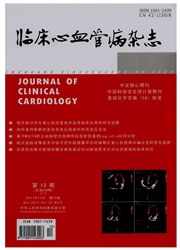

 中文摘要:
中文摘要:
目的:利用原代培养的心房肌细胞建立快速起搏模型,对心房颤动(房颤)早期的重构现象进行初步研究。方法:原代培养大鼠心房肌细胞,并建立快速电场刺激起搏细胞模型,利用全细胞膜片钳技术记录刺激前后心房肌细胞的动作电位周期,透射电镜观察细胞超微结构的变化。结果:培养至第4天,细胞生长密度可以达到瓶底70%左右,数目可达(2~3)×10^9/L,经免疫细胞化学鉴定,90%以上培养细胞α-肌动蛋白抗体染色阳性;全细胞膜片钳记录了培养心房肌细胞及经电场刺激(600次/min,1.5V/cm)24h后的心房肌细胞的动作电位周期,动作电位周期分别为(64.2±4.6)ms和(56.6±4.1)ms,刺激前后差异有统计学意义(P〈0.05)。透射电镜观察到刺激后心房肌细胞超微结构发生去分化改变。结论:经快速起搏24h后,心房肌细胞发生了电及结构重构;利用原代培养的心房肌细胞建立快速起搏的房颤模型,可以对房颤早期的重构机制进行研究。
 英文摘要:
英文摘要:
Objective:To explore early electrical and structural remodeling in atrial fibrillation utilizing a rapid paced primary cultured atrial myocyte model. Method: Primary rat atrial myocytes were cultured and established as a rapid paced primary cultured atrial myocyte model. Atrial cells were cultured in the presence of rapid field stimulation (600 beats per min, 1.5 V/cm) for 24 h. Action potential duration were recorded from stimulated cells and control cells using whole-cell voltage-clamp techniques. Ultrastructure of myocardial cells were observed under electron microscope. Result .. After 4 days of primary culture, the number of cells reached (2-3) )〈 10^6 per milliliter. Immunocytochemical analysis showed that over 90 percent of cells were stained positively forα-actin, a factor specific for cardiomyocytes. The action potential duration was shortened through the rapid pacing compared with those before pacing ( P 〈0.05). Results of electron microscope showed that atrial myocytes generated dedifferentiation through pacing. Conclusion:Rapid stimulation of atrial cells in culture produces electrical remodeling, recapitulating principal phenotypic features of atrial tachycardia remodeling in vivo. It is available that a rapid paced cell model is established with primary cultured atrial myocyte to study the mechanism of early electrical and structural remodeling for atrial fibrillation.
 同期刊论文项目
同期刊论文项目
 同项目期刊论文
同项目期刊论文
 期刊信息
期刊信息
